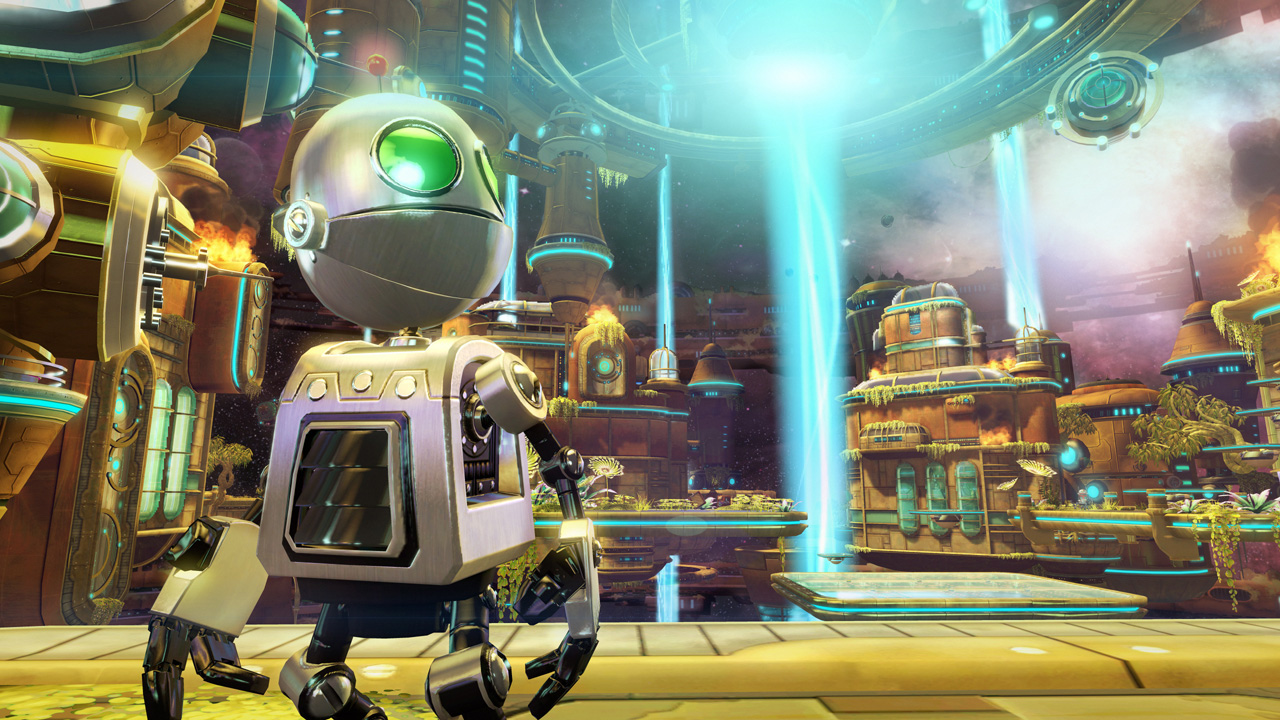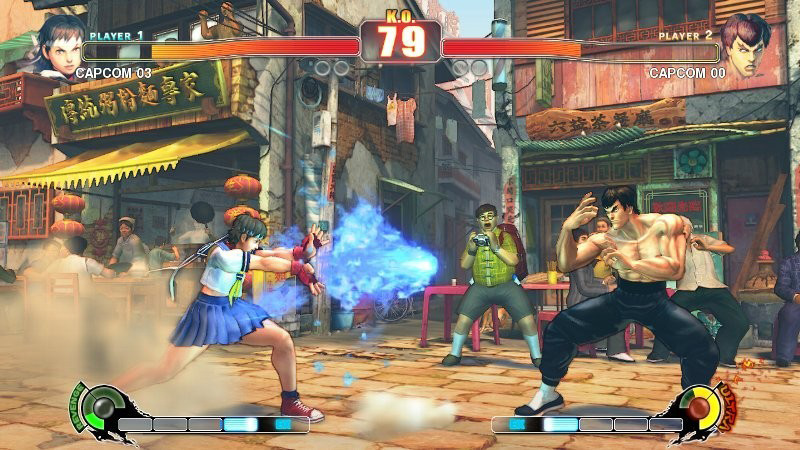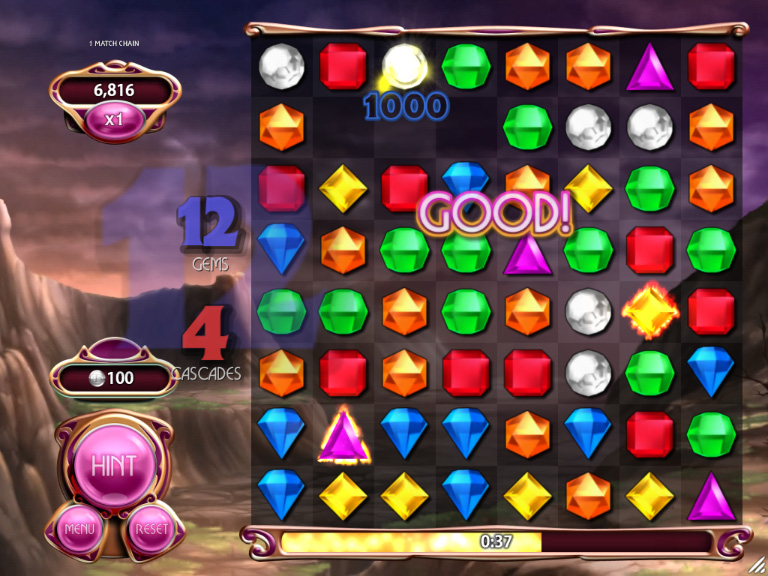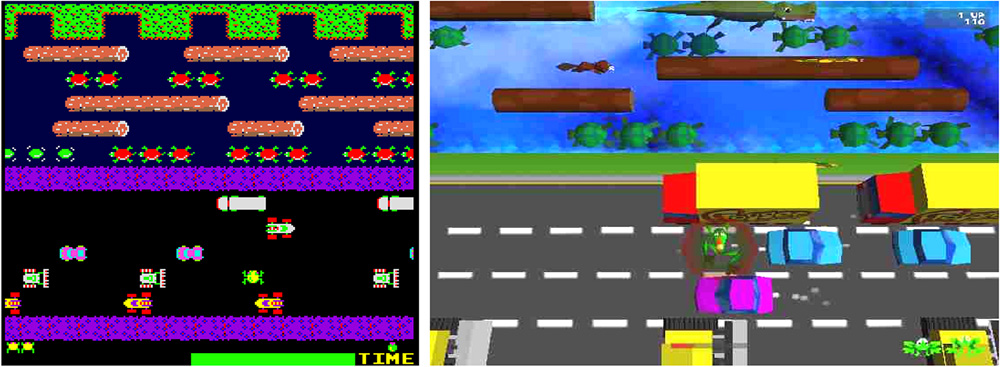Action Game Subgenres
Action games fall into a number of subgenres based, like all game genre distinctions, on the kinds of gameplay that they offer. The most familiar and popular action games are platform games, but the genre also encompasses fighting games, fast puzzle games, and a broad miscellany of others. Shooter games were considered a kind of action game for a long time, but now they are so distinct that they are a genre in their own right. Bear in mind that there is no industry standard for these terms, and other authors may refer to these subgenres by other names.
Platform Games
In platform games, or platformers, an avatar moves through a vertically exaggerated environment, jumping on and off platforms at different heights, while avoiding obstacles and battling enemies. The avatar has a supernatural jumping ability and usually can’t be harmed by falling long distances (unless he falls onto something dangerous or into a bottomless chasm, both common features of platform games). Most of the player’s actions consist of running and jumping, augmented by moves such as flips, wall climbs, and glides and by environmental features such as bouncy objects, wind, or warp points. Platform games use unrealistic physics; in particular, the avatar can usually change directions in midair.
The vast majority of 2D side-scrolling games with a humanoid avatar are platform games; Super Mario Bros. is the classic example. The conflict in platform games is often mild and suitable for children. Both Mario and Sonic the Hedgehog attacked enemies simply by jumping on top of them. Stricken enemies disappeared without undue anguish.
Crash Bandicoot is one of the more successful 3D platformers; the Ratchet & Clank Future series is another recent example (see Figure 1). The addition of a third dimension makes control and camera management more complicated; the “Controls” section, later in this e-book, discusses this in more detail.
Figure 1 Ratchet & Clank Future: A Crack in Time
Fighting Games
Fighting games have little in common with other action games because they involve neither exploration nor puzzle-solving. They still qualify as action games because they place great demands on a player’s physical skills: reaction time and timing. These games simulate hand-to-hand combat, usually using highly exaggerated moves vaguely modeled on Asian martial arts techniques. Some of them, such as the Super Smash Bros. series, also include ranged attacks and magic powers. (Serious boxing games belong more to the sports genre than to the action genre; they try to model the techniques of boxing realistically.) Fighting games may be further subdivided into those in which characters fight in one-on-one bouts, and mêlée games in which one or two characters fight against large numbers of opponents. (The latter are sometimes called beat-’em-ups or brawlers.) Fighting games also use hand-to-hand weapons, such as swords and staves, and a limited number of ranged weapons. Figure 2 shows a popular fighting game, Street Fighter IV.
Figure 2 Street Fighter IV
In fighting games, the player’s actions typically consist of hand-to-hand attacking and defending moves of various sorts. Typically, certain defenses block some attacks but not others, and players have to learn when and how the moves are effective through trial and error. Each successful attack takes energy away from the character hit, and the game continues until one fighter’s energy drops to zero. The strategy of the game rather resembles rock-paper-scissors as players try to guess which move their opponent will use next.
A common feature of fighting games is the combo move, often simply shortened to combo. Because early console and arcade machines offered only a small number of buttons and a simple eight-way joystick or D-pad, there was no way to assign a separate button to each of the moves that the designers wanted to include. To compensate for this and to create an extra challenge, they designed games so that the player would execute an especially effective or spectacular attack if she could rapidly issue a particular sequence of buttons and joystick maneuvers. The effectiveness of the move is often related to its difficulty of execution; more complex combos carry higher risk because the avatar is open to attack while the player carries out the sequence.
When the software detects that a player has started a combo move, it sometimes displays a combo meter somewhere on the screen—a visual indicator of the player’s progress through pressing the buttons. If the player stops or gets the sequence wrong, the meter resets to zero and she has to start over.
NOTE
Assassin’s Creed combines the close-combat fighting of a more conventional fighting game with the open world and missions of a Grand Theft Auto–style game, producing a unique hybrid.
Bout-structured fighting games tend to show all the fighters on-screen at once from a side view. Even in a game that uses 3D technology to display the world and the fighters, the play is largely 2D in the plane of the video screen. The fighters move left and right and may jump up and down, but they seldom move toward or away from the player. Again, realistic boxing games are an exception because they try to model the ring and boxers’ movements accurately—another reason why they’re not usually classed with fighting games.
Most innovation in fighting games consists of developments in the characters’ actions and reactions. This includes their interactions with each other and their environment and their reactions to injury, as well as the methods used to control the fighters—especially when considering how to handle special moves and combos.
Fast Puzzle Games
Most computerized puzzle games, such as Sokoban, move slowly and allow the player to think about his next move for as long as he wants, so they’re not action games. Fast puzzle games require the player to solve a problem as quickly as possible. These games are usually simple and visually abstract, have a limited control set, and are easy to design and build. Tetris is the archetypal fast puzzle game. Other examples include Collapse!, Word Warp, and Bejeweled Blitz, the time-limited version of Bejeweled (see Figure 3). Casual gamers like fast puzzle games because they are easy to learn and don’t take a long time to play. They also don’t use stereotypical content associated with many video games: no guns, no dragons, no scantily clad women. This subgenre is ideal for handheld devices and cell phones. The advent of touch screens has permitted natural, direct control of puzzle elements that joysticks weren’t very good at.
Figure 3 Bejeweled Blitz
Action-Adventures
The action-adventure is a hybrid genre, combining features from both action games and adventure games. To play them well requires a fair amount of physical skill, but they also offer a story line, numerous characters, an inventory system, dialogue, and other features of adventure games. The later editions of the Zelda series for the Nintendo 64 and Nintendo GameCube are action-adventures, as is Indiana Jones and the Infernal Machine. The earlier, 2D isometric Indiana Jones games were pure adventure games.
The e-book Fundamentals of Adventure Game Design discusses action-adventures in more detail. Visit www.peachpit.com/ernestadams to find this book and more.
Music, Dance, and Rhythm Games
The Just Dance series, Rhythm Heaven, and similar games belong to a subgenre of action games that emerged in the 1990s and challenge the player’s sense of rhythm. They typically show an avatar on screen who dances in response to the player’s input. In single-player mode, the player’s avatar must dance better than a computer-controlled character; in multiplayer mode, two avatars compete head to head. The screen shows which dance step the player should perform next, while the game awards points for pressing the correct button on the controller or performing the correct move with a motion sensitive device, and for being on the beat.
Music games are more recent arrivals. The huge success of Guitar Hero and Rock Band demonstrates that a lot of players want to enjoy the fantasy of being a musician—even though they don’t actually make music in these games. Much of the fun in these games comes from using their specialized, instrument-shaped controllers. A few, such as Rocksmith 2014, are designed to genuinely teach the player to play an instrument, and there are many singing games as well. Some music games are hybrids that incorporate music into platformer challenges. Maestro! Green Groove is one such game.
Other Action Games
A great many action games don’t fit neatly into any of the preceding subgenres, and the variety among them is enormous. They are difficult to categorize except in negative terms: They don’t involve shooting, hand-to-hand fighting, or abstract puzzle solving. They do, however, frequently use representational puzzle solving. Most of these action games demand skills such as maneuvering and path planning.
NOTE
Players could instantly understand what they were supposed to do in Frogger, which accounts for a lot of its success. It also appealed to both male and female players at a time when that was rare. These are qualities to strive for.
Frogger, shown in Figure 4 on the left, is a good example of an action game that belongs to no obvious subgenre. The player maneuvers the world’s only nonswimming frog family across a busy road and a logging river infested with crocodiles. A highly successful arcade game launched in 1981, eventually the Frogger series became one of the most successful of all time. Hasbro’s 1997 remake, Frogger 3D (shown in Figure 4 on the right) sold millions of copies, remaining on the software bestsellers charts for many months after release. The developers kept the gameplay virtually unchanged and just updated the presentation, increasing the variety of the levels available to the player. Frogger 2: Swampy’s Revenge, a sequel to Frogger 3D, introduced a more structured game while still remaining faithful to the gameplay of the original.
Other notable action games that don’t fit into defined subgenres include Pong, Marble Madness, Pac-Man, Q*bert, Lemmings, and Katamari Damacy. Marble Madness, Super Monkey Ball, and Katamari Damacy use an excellent but seldom-seen challenge: controlling a rolling object that exhibits inertia. Lemmings, a brilliant game about trying to prevent a group of dim-witted creatures from killing themselves by falling off cliffs, involves selecting particular creatures and assigning tasks to them that influence the way the others move, all under time pressure.
Figure 4 Frogger and Frogger 3D




